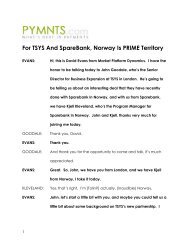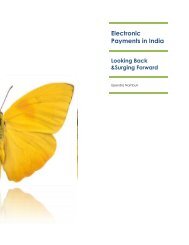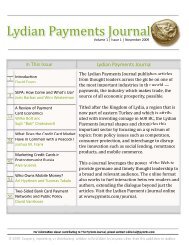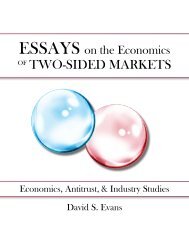Interchange Fees: The Economics and Regulations of What
Interchange Fees: The Economics and Regulations of What
Interchange Fees: The Economics and Regulations of What
- No tags were found...
You also want an ePaper? Increase the reach of your titles
YUMPU automatically turns print PDFs into web optimized ePapers that Google loves.
<strong>The</strong> <strong>Economics</strong> <strong>of</strong> <strong>Interchange</strong> <strong>Fees</strong> <strong>and</strong> <strong>The</strong>ir Regulation: An Overview 31In both Australia <strong>and</strong> Europe, the regulators (or at least their economic consultants) recognizedthat socially optimal interchange fees also depend on dem<strong>and</strong> factors or network effectsbut, presumably, decided not to incorporate those factors because <strong>of</strong> the difficulty <strong>of</strong> doing so,citing instead the “objectivity” <strong>and</strong> “transparency” benefits <strong>of</strong> a cost-based measure. 81 Objectivity<strong>and</strong> transparency may have benefits, <strong>of</strong> course, but by themselves they do not, necessarily lead togreater economic efficiency.Although cost-based interchange fee regulation could by happenstance improve the efficiency<strong>of</strong> the payment system, there are two fundamental reasons to doubt that it would regularly do soin practice. <strong>The</strong> first is that regulating the interchange fee will not necessarily have a significanteffect on the variable prices paid by cardholders <strong>and</strong> therefore will not necessarily have a significanteffect on the volume <strong>of</strong> transactions—generally the putative target <strong>of</strong> the intervention. <strong>The</strong> secondis that even if regulating the interchange fee could affect the variable prices paid by both merchants<strong>and</strong> cardholders, cost-based regulation is not capable <strong>of</strong> achieving the optimal prices except by happenstance.Whether cost-based regulation in practice would increase efficiency is unknown giventhe current state <strong>of</strong> theoretical <strong>and</strong> empirical knowledge.C. Competition Policy <strong>and</strong> <strong>Interchange</strong> Fee DeterminationRelatively early in the development <strong>of</strong> the payment card industry, the NaBanco court recognizedthe complexity <strong>of</strong> the role played by the interchange fee <strong>and</strong> the differences between thatrole <strong>and</strong> the role <strong>of</strong> an ordinary price in deciding that interchange fees should be evaluated underthe rule <strong>of</strong> reason rather than be subject to the per se condemnation <strong>of</strong> price-fixing under U.S.law. We believe the recent theoretical literature supports this approach. <strong>The</strong>re is a strong economicpresumption that collective determination <strong>of</strong> ordinary prices harms consumers, relative touncoordinated, competitive pricing, but there is no economic presumption that collectively settinginterchange fees reduces output or consumer welfare as compared to any other feasible regime.Under U.S. law, to evaluate whether the pro-competitive benefits <strong>of</strong> collectively set interchangefees outweigh the anti-competitive costs (the test under the rule <strong>of</strong> reason), one would presumablyhave to compare collectively set interchange fees with the results <strong>of</strong> bilateral negotiations amongacquirers <strong>and</strong> issuers. 82 As we have discussed, bilateral negotiation would at the very least involvehigh transactions costs in systems, like those in the United States, with large numbers <strong>of</strong> issuers <strong>and</strong>acquirers, <strong>and</strong> it may not be feasible in such systems. But assume it is feasible, <strong>and</strong> assume away theassociated transactions costs. <strong>The</strong>n one would have to examine whether bilateral negotiations wouldlead to lower prices <strong>and</strong> higher output than collectively set interchange fees. Existing theory doesnot provide much help in predicting the outcome <strong>of</strong> such bilateral negotiations, 83 <strong>and</strong>, <strong>of</strong> course, the81Reserve Bank <strong>of</strong> Australia (2002, p. 12); Katz (2001, p. 29); European Commission (2002).82That is the remedy that was sought by the plaintiff in NaBanco.83As we noted above, Small <strong>and</strong> Wright (2000) conclude bilateral negotiation would threaten system viability, but it isunclear how robust this result is.








